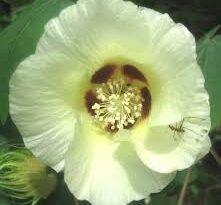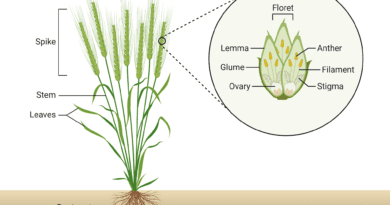Thinning of Plantain Suckers and the Importance
Plantain, Musa × paradisiaca (syn. Musa sapientum) is an herbaceous perennial belonging to the family Musaceae. Plantains are distinguished from bananas by their fruit which, although morphologically very similar to bananas, are actually longer, firmer and possess a higher starch content and thicker skin than their sweeter relative. Like banana, the plant is tall and tree-like with a sturdy pseudostem and large broad leaves arranged spirally at the top.
The leaves are large blades with a pronounced central midrib and obvious veins. They can reach up to 2.7 m (8.9 ft) in length and up to 0.6 m (2.0 ft) in width. Each pseudostem produces a group of flowers from which the fruits develop in an hanging cluster. In commercial plantations, the parent plant dies after harvest and is replaced with a daughter plant. However, a plantation can grow for 25 years or more if managed properly. The trees can reach heights between 2 and 9 m (6.6–29.5 ft).
Unlike those of most other bananas, plantain suckers develop very slowly. After harvest, all suckers start to grow at the same time and most have to be eliminated to stop competition. The tallest is left to guarantee the follow up and maintain the density.
Thinning usually has to be repeated a month later, as new suckers will have emerged by that time.
A sucker is a shoot that develops from a lateral bud on the rhizome and emerges from the soil usually near the parent plant. It is a form of asexual, or vegetative, reproduction, that makes the banana plant perennial. Suckers emerge and ensure a more or less continuous supply of shoots, each capable of producing an inflorescence. They have been used as planting material since the early days of domestication by severing them from the mat and transplanting them to a new location.
Both wild species of plantains / bananas and cultivated plantains / bananas produce suckers. The horticultural term for the clump of shoots and the rhizome through which they are interconnected is a mat. The botanical term for a mat is genet and for the above-ground ground shoots is ramet.
Wild species may produce few or many suckers. Over time, some form dense and compact mats. This strategy, together with dormant seeds that germinate in disturbed soil, enables wild bananas to quickly colonise the edges of disturbed forest clearings. Norman Simmonds referred to wild bananas as “jungle weeds”.
Suckers are thinned with a machete. The sucker pseudo stem is cut off near its corm and the point of the machete is twisted in the growing tip, thus killing it.
An excess of suckers can lead to reduced bunch weight, especially in ratoon crops. The number of suckers that are allowed to develop and mature is managed by pruning (desuckering).
Considerations such as the evenness of the crop and the position of the sucker in relation to the direction of the row and in relation to the bunch on the parent plant influence the selection of the follower in commercial plantations of Cavendish cultivars. Suckers can also be managed to time harvesting to meet market demands.
Read Also: Required Spacing for Plantain Cultivation
Types of Plantain / Banana Suckers
The sucker appears above the soil and its state is characterised in part by its appearance. Initially, suckers have only leaf sheaths without a midrib or lamina. In horticultural terminology they are called peeper suckers.
Some remain at this stage without further growth. Others continue to grow and produce leaves with a midrib and a very narrow lamina. They are then called sword suckers. Sword suckers gradually produce leaves whose laminae are broad and of the adult form (see photo).
The sucker selected to replace the parent plant is called the follower or ratoon. Sometimes, ratoon suckers that have not fruited are referred to as maiden suckers, although this term is poorly defined, and it can be difficult to determine whether a sucker at this stage is vegetative or contains an unemerged bunch.
Lateral buds may survive on sections of the rhizome after the aerial stems of earlier generations have decayed. Suckers that arise from these lateral buds usually have a small rhizome and broad leaves. They are called water suckers and their connection to the rhizome is often structurally weak.
For this reason, water suckers are not suitable for selection as a ratoon to continue the life of the mat into the next generation. However, water suckers can still be a source of planting material to establish a new plantation. Oppenheimer and Gottreich compared sword and water suckers, excised from the parent plant and of equivalent height at planting. For plants that flowered at the same time, bunches from sword suckers and water suckers were of a similar size.
Read Also: Selecting the site for Plantain Cultivation
Common Pests and Diseases
Diseases
Category : Fungal
Anthracnose Colletotrichum musae
Symptoms
Cause
Comments
Management
Commercially produced fruit should be washed and dipped in fungicide prior to shipping; protect fruit from injury; remove flower parts which can harbour fungus.
Black sigatoka Mycosphaerella fijiensis
Symptoms
Cause
Comments
Management
Export plantations may require regular fungicide applications; increase plant spacing to improve air circulation and reduce humidity; remove leaves with mature spots.
Panama disease (Fusarium wilt) Fusarium oxysporum
Symptoms
Cause
Comments
Management
Use disease free seed pieces; currently no effective treatment once plants are infected.
Rhizome rot Erwinia carotovora
Erwinia chrysanthemi
Symptoms
Cause
Comments
Management
Select only high quality, disease-free rhizomes for propagation; disinfect all tools used for propagation regularly; allow seed pieces to dry before planting.
Category : Viral
Bunchy top Banana bunchy top virus (BBTV)
Symptoms
Cause
Comments
Management
Plant less susceptible varieties; destroy infected plants to prevent spread of disease.
Category : Bacterial
Moko disease Ralstonia solanacearum
Symptoms
Cause
Comments
Management
Plantations should be regularly monitored for presence of disease; if Moko is present, male buds should be removed and all tools thoroughly disinfected; infected plants may need to be destroyed along with any neighboring plants.
Pests
Category : Insects
Banana aphid Pentalonia nigronervosa
Symptoms
Cause
Comments
Management
Chemical control does not provide protection against transmission of Banana bunchy top and direct feeding damage is not usually severe enough to warrant spraying; insecticidal soaps can help control aphid populations; plants infected with bunch top should be removed and destroyed to prevent spread.
Banana weevil Cosmopolites sordidus
Symptoms
Cause
Comments
Management
Plant only healthy plant material, do not plant if any tunnels are visible; hot water treatment of clean trimmed suckers can be used to kill off many eggs and grubs; applications of neem powder can reduce weevil numbers; appropriate insecticides applied at time of planting can help control weevil numbers.
Coconut scale Aspidiotus destructor
Symptoms
Cause
Comments
Management
Biological control is the best way to manage scale, with lady beetles providing the most effective protection.









